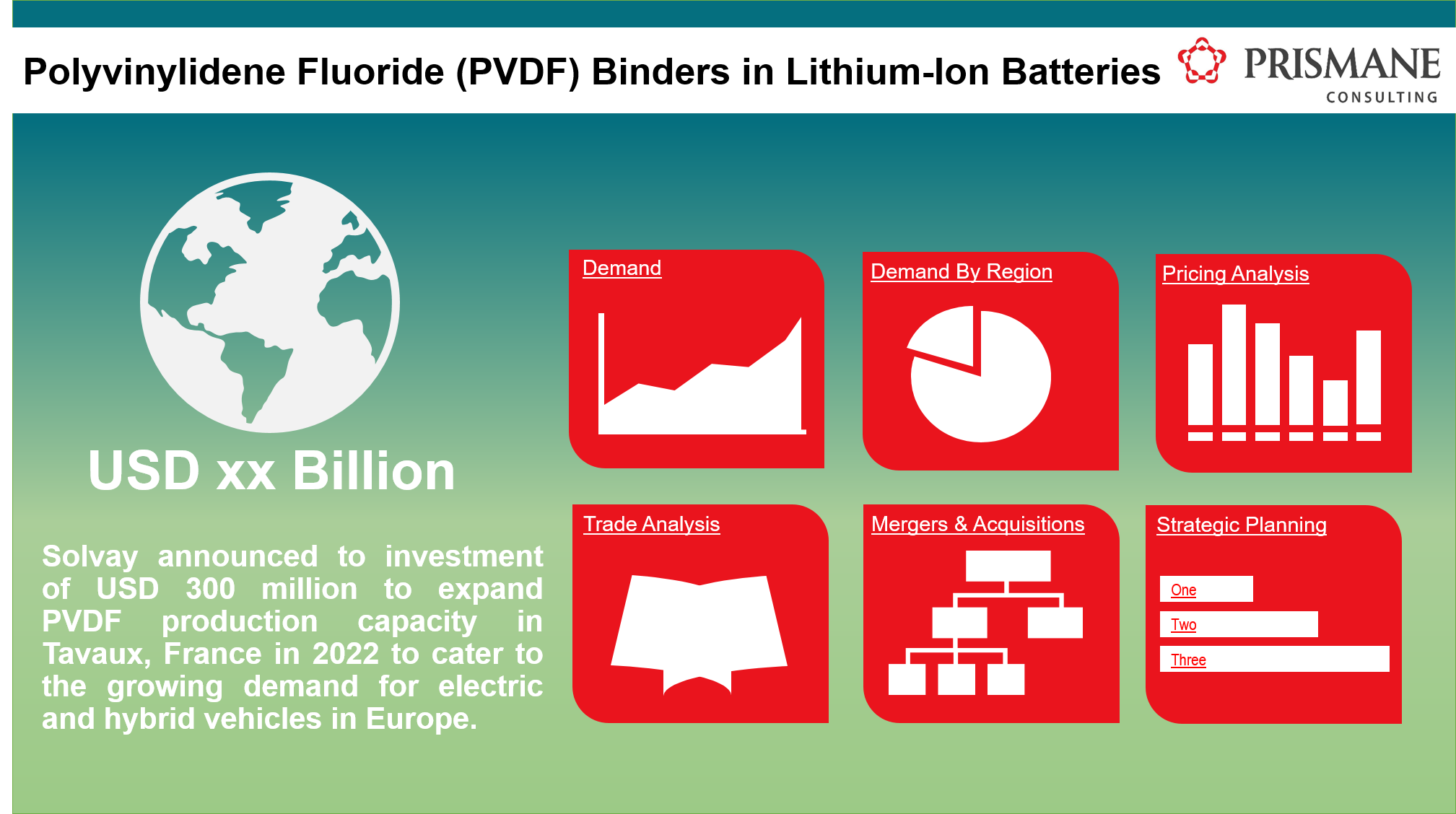Lithium-ion Battery (PVDF) Binders Market Overview
A lithium-ion battery consists of components such as electrodes, cathode and anode, a separator, and an electrolyte mixture. The electrodes are coated with an aluminum current collector and copper current collector to facilitate the electrochemical process. Polyvinylidene Fluoride acts as a connecting agent between electrode species and adheres them to electricity-based collectors to increase the life span and energy density of electrodes. PVDF binders offer properties such as high electrochemical, and thermal stability, low melting point, and high chemical resistance to solvents.
Solvay and Kureha are some of the significant players in the PVDF market. Solvay produces PVDF binders with the brand name Solef® PVDF for applications in electrodes and as a coating material in separators. Other than lithium-ion batteries, the product is also used in oil and gas, semiconductors, water filtration membranes, photovoltaics, architectural coatings, and plumbing.
Lithium-ion Battery (PVDF) Binders Applications
The market for PVDF binders is driven by the growing demand for lithium-ion batteries globally and new technology development in batteries. Lithium-ion batteries are used in a variety of electronics such as pacemakers, digital cameras, laptops, smartphones, watches, surveillance, alarm systems, and electric vehicles. The growth of lithium-ion batteries is majorly driven by the rising demand for battery electric vehicles globally. A lithium-ion battery is a preferred choice in electric vehicles owing to its properties such as improved energy density, life cycle, wide temperature operationality, fast charging, and self-discharge. Increasing adoption of electric vehicles on the back of sustainability awareness, advancement in battery technology, and government incentives are driving the market of lithium-ion batteries. The sale of EVs is increasing owing to the growing demand for light-duty vehicles to reduce emissions.
To learn more about this report, request a free sample copy - Please click here
For example, according to the International Energy Association, the global sale of electric vehicles was more than 10 million in 2022. Road transport accounts for 15% of the global energy-related emissions and electric vehicles play a key role in decarbonizing road transport. The market share of electric cars in total EV sales grew from 4% in 2020 to around 14% in 2022. China is one of the significant markets of electric vehicles globally. As per data referred from Statista,
China produced around 2.9 million battery electric vehicles, a year-on-year growth of 166% from 2020. As per The International Council on Clean Transportation, China’s sales of EVs grow by 150% in 2021 to reach around 3.5 million units in 2020. Europe followed China with around 2.3 million units being sold in the region in 2021. Germany, France, the UK, Italy, Sweden, Netherlands, and Norway were among the top markets for EV sales in Europe.
Government incentives also play a key role in the growth of electric vehicles globally. For example, the Indian government introduced FAME, Faster Adoption and Manufacturing of Electric Vehicles, the scheme to encourage electric mobility in the country. The Chinese government introduced a tax break incentive package in 2023 of USD 72.3 Billion over a span of 4 years to boost the sale of electric vehicles and other green cars in the country.
Lithium-ion Battery (PVDF) Binders Demand Analysis
Additionally, development in battery technology by automakers is also boosting the market of PVDF binders globally. For example, Automaker Toyota is investing in solid-state battery technology for electric vehicles and is expected to commercialize the production of solid-state battery by 2025. Solid-state batteries are expected to reduce charging time, increase capacity, and lower the risk of fire associated with lithium-ion batteries.
The University of Texas is developing lithium-sulfur battery technology for use in electric vehicles. The new battery will provide higher energy density than lithium-ion batteries and will have a lower cost of production using sustainable materials. Lithium-sulfur batteries will be more environmentally friendly owing to being produced from sustainable materials. Currently, batteries have a shorter lifespan than lithium-ion batteries, and a solution is being developed to solve the challenge.
To learn more about this report, request a free sample copy - Please click here
Recent Developments
Solvay announced to investment of USD 300 million to expand PVDF production capacity in Tavaux, France in 2022 to cater to the growing demand for electric and hybrid vehicles in Europe. The investment is expected to complete by December 2023 and will increase the production capacity of PVDF in France by 35 thousand tons, making Tavaux, the largest production site in Europe.
Kureha Corporation of Japan announced plans in 2023 to boost the capacity production of PVDF at the Iwaki factory in Fukushima, Japan. Kureha will expand the capacity from 11 thousand tons to 20 thousand tons by March 2027 through debottlenecking and an additional new production line of 8 thousand tons will also be installed for capacity expansion.

